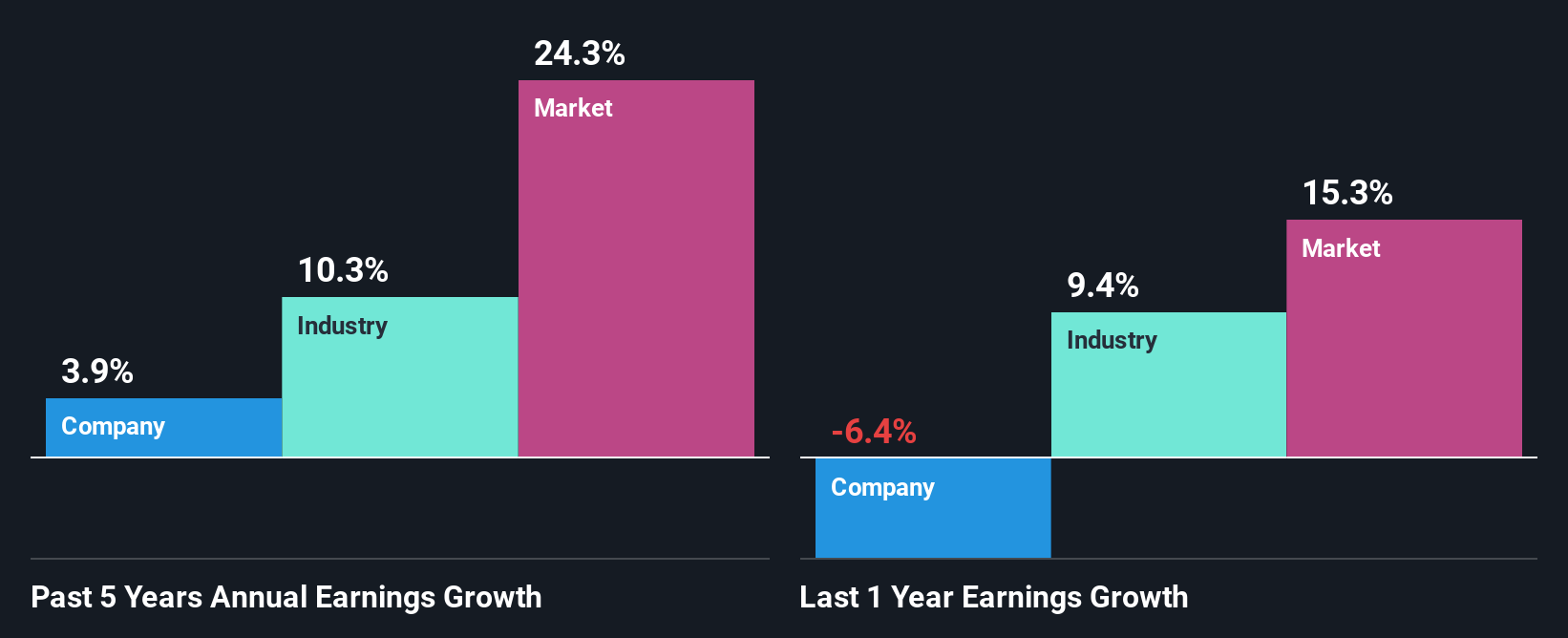SRF Limited (NSE:SRF) Is Going Strong But Fundamentals Appear To Be Mixed : Is There A Clear Direction For The Stock?
SRF's (NSE:SRF) stock is up by a considerable 12% over the past month. However, we decided to pay attention to the company's fundamentals which don't appear to give a clear sign about the company's financial health. Particularly, we will be paying attention to SRF's ROE today.
ROE or return on equity is a useful tool to assess how effectively a company can generate returns on the investment it received from its shareholders. In short, ROE shows the profit each dollar generates with respect to its shareholder investments.
How To Calculate Return On Equity?
The formula for ROE is:
Return on Equity = Net Profit (from continuing operations) ÷ Shareholders' Equity
So, based on the above formula, the ROE for SRF is:
9.9% = ₹13b ÷ ₹126b (Based on the trailing twelve months to March 2025).
The 'return' is the income the business earned over the last year. One way to conceptualize this is that for each ₹1 of shareholders' capital it has, the company made ₹0.10 in profit.
See our latest analysis for SRF
What Is The Relationship Between ROE And Earnings Growth?
We have already established that ROE serves as an efficient profit-generating gauge for a company's future earnings. Depending on how much of these profits the company reinvests or "retains", and how effectively it does so, we are then able to assess a company’s earnings growth potential. Assuming all else is equal, companies that have both a higher return on equity and higher profit retention are usually the ones that have a higher growth rate when compared to companies that don't have the same features.
A Side By Side comparison of SRF's Earnings Growth And 9.9% ROE
When you first look at it, SRF's ROE doesn't look that attractive. However, given that the company's ROE is similar to the average industry ROE of 9.4%, we may spare it some thought. We can see that SRF has grown at a five year net income growth average rate of 3.9%, which is a bit on the lower side. Bear in mind, the company's ROE is not very high . So this could also be one of the reasons behind the company's low growth in earnings.
As a next step, we compared SRF's net income growth with the industry and were disappointed to see that the company's growth is lower than the industry average growth of 10% in the same period.

Earnings growth is a huge factor in stock valuation. What investors need to determine next is if the expected earnings growth, or the lack of it, is already built into the share price. Doing so will help them establish if the stock's future looks promising or ominous. One good indicator of expected earnings growth is the P/E ratio which determines the price the market is willing to pay for a stock based on its earnings prospects. So, you may want to check if SRF is trading on a high P/E or a low P/E, relative to its industry.
Is SRF Making Efficient Use Of Its Profits?
SRF's low three-year median payout ratio of 12% (or a retention ratio of 88%) should mean that the company is retaining most of its earnings to fuel its growth. However, the low earnings growth number doesn't reflect this fact. Therefore, there might be some other reasons to explain the lack in that respect. For example, the business could be in decline.
Additionally, SRF has paid dividends over a period of at least ten years, which means that the company's management is determined to pay dividends even if it means little to no earnings growth. Upon studying the latest analysts' consensus data, we found that the company's future payout ratio is expected to drop to 9.2% over the next three years. The fact that the company's ROE is expected to rise to 17% over the same period is explained by the drop in the payout ratio.
Summary
On the whole, we feel that the performance shown by SRF can be open to many interpretations. Even though it appears to be retaining most of its profits, given the low ROE, investors may not be benefitting from all that reinvestment after all. The low earnings growth suggests our theory correct. That being so, the latest analyst forecasts show that the company will continue to see an expansion in its earnings. Are these analysts expectations based on the broad expectations for the industry, or on the company's fundamentals? Click here to be taken to our analyst's forecasts page for the company.
New: Manage All Your Stock Portfolios in One Place
We've created the ultimate portfolio companion for stock investors, and it's free.
• Connect an unlimited number of Portfolios and see your total in one currency
• Be alerted to new Warning Signs or Risks via email or mobile
• Track the Fair Value of your stocks
Have feedback on this article? Concerned about the content? Get in touch with us directly. Alternatively, email editorial-team (at) simplywallst.com.
This article by Simply Wall St is general in nature. We provide commentary based on historical data and analyst forecasts only using an unbiased methodology and our articles are not intended to be financial advice. It does not constitute a recommendation to buy or sell any stock, and does not take account of your objectives, or your financial situation. We aim to bring you long-term focused analysis driven by fundamental data. Note that our analysis may not factor in the latest price-sensitive company announcements or qualitative material. Simply Wall St has no position in any stocks mentioned.
About NSEI:SRF
SRF
Manufactures, purchases, and sells technical textiles, chemicals, packaging films, and other polymers.
Flawless balance sheet with reasonable growth potential and pays a dividend.
Similar Companies
Market Insights
Community Narratives




